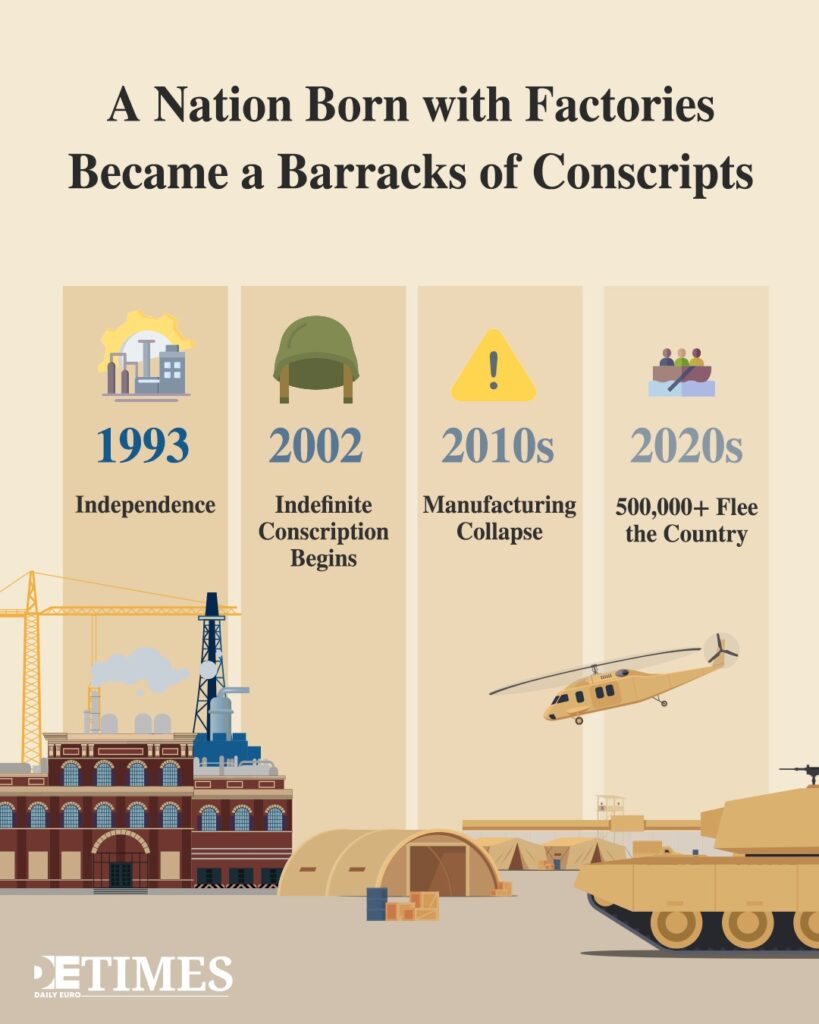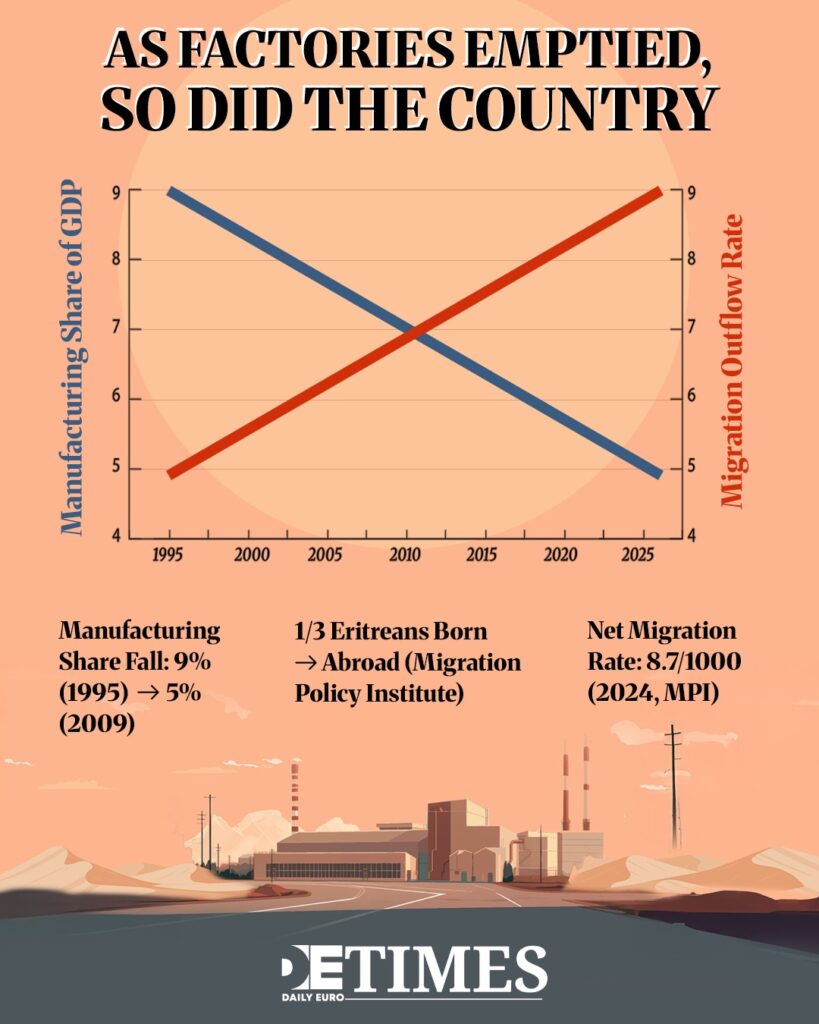Last week, Ethiopia’s foreign minister sent a blunt letter to the UN, accusing Eritrea of actively preparing for war and working with the Tigray People’s Liberation Front to launch a military offensive.
Addis Ababa claims that Eritrea and TPLF hardliners are “funding, mobilising and directing armed groups” in northern Ethiopia. These accusations echo long-standing tensions between the two nations.
Eritrean President Isaias Afwerki dismissed Ethiopian Prime Minister Abiy Ahmed’s Red Sea ambitions as the work of a “crazy person.”
A Country Once Admired
Eritrea became independent from Ethiopia in 1993 after a fierce 30-year war.
When it gained independence, the country had something unusual in Africa: a functioning industrial base. Italian colonisers had set up factories, breweries, textile mills, and food processing plants around Asmara.
This infrastructure gave Eritrea economic strength that few African nations had at the time of independence. Isaias Afwerki, the liberation hero who became president, inherited this foundation. Over the next three decades, he gradually tore it down.

The Architecture of Collapse
Instead of using industry to develop the country, Isaias imposed indefinite military conscription. Young Eritreans were forced into long-term military service, which critics call state-sponsored ‘slavery’. The government tightly controlled the economy.
Foreign investment dried up because of laws meant to protect local businesses. The government rejected foreign aid and stayed hostile to international organisations. Manufacturing shrank, environmental damage worsened, and hundreds of thousands fled the country.
The 3.5 million people still living there are under one of the world’s harshest governments. Eritrea became a closed-off, isolated state with little freedom. The factories that could have driven growth remain unused.

Addis Ababa’s Maritime Obsession
Ethiopia lost its legal access to the sea after Eritrea became independent. Prime Minister Abiy Ahmed has promised to regain that access, seeking Red Sea ports through negotiation or force.
This desire for sea access is a key factor behind current tensions, more than any immediate military threat. Eritrea fears Ethiopia will try to expand, while Ethiopia depends on maritime routes for trade. Neither side trusts the other to negotiate honestly.
The two countries briefly made peace in 2018 when Abiy became prime minister. Isaias and Abiy signed a peace deal restoring diplomatic relations. The UN lifted sanctions on Eritrea. During the 2020-2022 Tigray war, Eritrean forces fought alongside Ethiopian troops.
That cooperation has since collapsed. By early 2024, Isaias reportedly opened secret talks with the TPLF, the group Eritrea once fought against, turning them into a possible ally against Ethiopia.
New Alignments Bring Old Dangers
Regional tensions have grown. Eritrea strengthened ties with Egypt, which is at odds with Ethiopia over Nile water. Egypt sees Ethiopia’s Grand Renaissance Dam as a threat to its water supply.
Egypt’s partnership with Eritrea adds complexity to the region’s instability. Sudan's weak military government, supported by Eritrea, accuses Ethiopia of cross-border attacks. There’s a real threat Sudan could get pulled into a larger conflict if Addis decides to launch any attack in Tigray or Eritrea.
Political analyst Abel Abate Demissie told The Africa Report that Isaias has a more threatening tone in recent speeches. This is the first time he’s talked so openly about his changed stance toward Addis Ababa, said Demissie. “The relationship seems beyond repair.”
What Happens Next
In March, Ethiopia deployed troops near the Eritrean border. Eritrea responded with nationwide military mobilization in February. Both sides have strengthened defenses along the border.
The Pretoria Agreement of 2022 that ended the Tigray war has not been fully put into action. Eritrean troops never completely left Tigray, and Ethiopia tolerated their presence, viewing it as a buffer against a TPLF-Eritrea alliance.
That approach backfired. The TPLF and Eritrea seem to have formed a tactical alliance. In May, Ethiopian officials withdrew the TPLF's legal status and imposed fuel shortages and travel restrictions similar to those from before the war.
International involvement is still minimal. The Horn of Africa is low on the US agenda. The United States has yet to appoint a special envoy for the region. Efforts by the European Union are stalled due to disagreements among member states.
The Wasteland Isaias Built
Political analyst Constantinos Berhutesfa warned that entering this conflict requires careful thought, because ending it would be impossible. A war between Ethiopia and Eritrea would destroy both countries and unsettle the whole region.
But Eritrea’s real disaster has already happened. Isaias turned a country with functioning industry into a poor, heavily militarised state. Factories are abandoned. People serve endlessly in the military. Young people leave whenever they can under the guise of repression.
Whether Ethiopia’s accusations lead to war or not, Eritrea’s fall from Africa’s most industrialised newly independent nation to an isolated wasteland is complete. Nothing can bring back what Isaias destroyed during his long rule.
Keep up with Daily Euro Times for more updates!
Read also:
Tigray Tinderbox Risks Regional Conflict in Horn of Africa
All Bets on Addis: Europe’s Reset in Africa
Nile Tensions: South Sudan at Risk of Renewed Conflict






